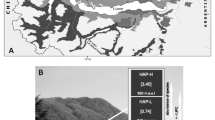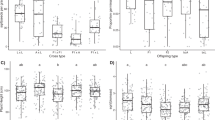Abstract
Natural hybridization frequently promotes gene introgression among closely related species in sympatric populations, producing complex patterns of morphological variation. Therefore, a detailed understanding of the dynamics of interspecific gene flow and its morphological patterns is of widespread interest. We tested if introgressive hybridization promotes an increase in transgressive characters in comparison with the parental species. A sunflower species complex occurring in Mexico formed by two native invasive species, Tithonia tubaeformis and Tithonia rotundifolia, was analyzed using 46 morphological characters (leaf, flower and fruit) in five hybrid zones (N = 150 individuals) and two pure sites for each parental species (N = 80 individuals). In general, T. tubaeformis differed significantly from T. rotundifolia in all the examined characters, except six foliar and one inflorescence character. Morphological characters support the hypothesis of hybridization in this complex, even though both species remain morphological distinct in mixed stands. Individual hybrids appear to be a mosaic of parent-like (24.8 % of traits), intermediate (26.1 %) and transgressive (37.8 %) phenotypes (the remaining 11.3 % of the traits did not differ significantly from both parental species). Our results suggest that individuals from the same parental species were more similar among themselves than to putative hybrids, indicating occasional hybridization with segregation in hybrid types or backcrossing to parents. Evidence indicates a unidirectional pattern of gene flow toward T. rotundifolia.


Similar content being viewed by others
References
Agrawal A (2001) Phenotypic plasticity in the interactions and evolution of species. Science 294:321–326
Anderson E (1949) Introgressive hybridization. Wiley, New York
Anderson E (1953) Introgressive hybridization. Biol Rev 28:280–307
Aparicio MS, Castro-Ramírez AE, León CJL, Ishiki IM (2003) Entomofauna asociada a maíz de temporal con diferentes manejos de malezas en Chiapas, México. Manejo Integrado de Plagas y Agroecología 70:65–73
Arnold ML (1997) Natural hybridization and evolution. Oxford University Press, New York
Blumler MA (2003) Introgression as a spatial phenomenon. Phys Geogr 24:414–432
Brennan CA, Bridle JR, Wang AL, Hiscock SJ, Abbott RJ (2009) Adaptation and selection in the Senecio (Asteraceae) hybrid zone on Mount Etna, Sicily. New Phytol 183:702–717
Brochmann C, Borgen L, Stabbetorp OE (2000) Multiple diploid hybrid speciation of the Canary Island endemic Argyranthemum sundingii (Asteraceae). Plant Syst Evol 220:77–92
Bruschi P, Vendramin GG, Bussotti F, Grossoni P (2000) Morphological and molecular differentiation between Quercus petrea (Matt.) Liebl. and Quercus pubescens Willd. (Fagaceae) in northern and central Italy. Ann Bot-London 85:325–333
Buerkle CA, Morris RJ, Asmussen MA, Rieseberg LH (2000) The likelihood of homoploid hybrid speciation. Heredity 84:441–451
Caraway V, Carr GD, Morden CW (2001) Assessment of hybridization and introgression in lava-colonizing Hawaiian Dubautia (Asteraceae: Madiinae) using RAPD markers. Am J Bot 88:694–16881
Carney SE, Gardner KA, Rieseberg LH (2000) Evolutionary changes over the fifty-year history of a hybrid population of sunflowers (Helianthus). Evolution 54:462–474
Cattell MV, Karl SA (2004) Genetics and morphology in a Borrichia frutescens and B. arborescens (Asteraceae) hybrid zone. Am J Bot 91:1757–1766
Daehler C, Strong DR (1997) Hybridization between introduced smooth cordgrass (Spartina alterniflora; Poaceae) and native California cordgrass (S. foliosa) in San Francisco Bay, California, USA. Am J Bot 84:607–611
Ellstrand NC, Schierenbeck KA (2000) Hybridization as a stimulus for the evolution of invasiveness in plants? Proc Natl Acad Sci 97:7043–7050
Freeman DC, Turner WA, McArthur ED, Graham JH (1991) Characterization of a narrow hybrid zone between two subspecies of big sagebrush (Artemisia tridentata: Asteraceae). Am J Bot 78:805–815
García AN, Chaila S, González Navarro H, de la Vega M, Raimondo JG (2000) Competencia específica de Tithonia tubaeformis [Jack] Cass. en cultivos de soja (Glycine max (L.) Merril) y poroto negro (Phaseolus vulgaris L.). Revista Agronómica del Noroeste Argentino 30:19–30
González-Rodríguez A, Arias DM, Valencia S, Oyama K (2004) Morphological and RAPD analysis of hybridization between Quercus affinis and Q. laurina (Fagaceae), two Mexican red oaks. Am J Bot 91:401–409
Gray AJ, Marshall DF, Raybould AF (1991) A century of evolution in Spartina anglica. Adv Ecol Res 21:1–62
Hardig TM, Brunsfeld SJ, Fritz RS, Morgan M, Orians CM (2000) Morphological and molecular evidence for hybridization and introgression in a willow (Salix) hybrid zone. Mol Ecol 9:9–24
Harrison RG (1990) Hybrid zones: windows on evolutionary process. Oxford Surv Evol Biol 7:69–128
Heiser CB (1947) Hybridization between the sunflower species Helianthus annus and H. petiolaris. Evolution 1:249–262
Heiser CB (1951) Hybridization in the annual sunflowers: Helianthus annuus × H. debilis var. cucumerifolius. Evolution 5:42–51
Hejda M, Pysek P, Jarosik V (2009) Impact of invasive plants on the species richness, diversity and composition of invaded communities. J Ecol 97:393–403
James JK, Abbott RJ (2005) Recent, allopatric, homoploid hybrid speciation: the origin of Senecio squalidus (Asteraceae) in the British Isles from a hybrid zone on Mount Etna, Sicily. Evolution 59:2533–2547
Jian O, Changyi LU, O’Toole DK (2008) A risk assessment system for alien plant bio-invasion in Xiamen, China. J Environ Sci 20:989–997
Jörgensen S, Mauricio R (2005) Hybridization as a source of evolutionary novelty: leaf shape in a Hawaiian composite. Genetica 123:171–179
Kim SC, Rieseberg LH (1999) Genetic architecture of species differences in annual sunflowers: implications for adaptive trait introgression. Genetics 153:965–977
Kleinschmit JRG, Bacilieri R, Kremer A, Roloff A (1995) Comparison of morphological and genetic traits of penduculate oak (Quercus robur (L.)) and sessile oak (Quercus petrea (Matt.)) Liebl). Silvae Genet 44:5–6
La Duke JC (1982) Revision of Tithonia. Rhodora 84:453–522
Lane MA (1996) Pollination biology of Compositae. In: Caligari PDS, Hind DJN (eds) Compositae: Biology and utilization. Kew: Proceedings of the International Compositae Conference, pp 61–80
Larenas-Parada G, Viana ML, Chafatinos T, Escobar NE (2004) Relación suelo-especie invasora (Tithonia tubaeformis) en el sistema ribereño del río Arenales, Salta, Argentina. Ecol Austral 14:19–29
Levin DA (2000) The origin, expansion, and demise of plant species. Oxford University Press, New York
Levin DA, Francisco-Ortega J (1996) Hybridization and the extinction of rare plant species. Conserv Biol 10:10–16
Lexer C, Randell RA, Rieseber LH (2003) Experimental hybridization as a tool for studying selection in the wild. Ecology 84:1688–1699
MacDonald IAW, Reaser JK, Bright C, Neville LE, Howard GW, Murphy SJ, Preston G (eds) (2003) Invasive alien species in southern Africa: national reports and directory of resources. Global Invasive Species Programme, Cape Town, South Africa
Mallet J (2005) Hybridization as an invasion of the genome. Trends Ecol Evol 20:229–237
Mito T, Uesugi T (2004) Invasive alien species in Japan: the status quo and the new regulation for prevention of their adverse effects. Global Environ Res 8:171–191
Mráz P, Gaudeul M, Rioux D, Gielly L, Choler P, Taberlet P (2007) Genetic structure of Hypochaeris uniflora (Asteraceae) suggests vicariance in the Carpathians and rapid post-glacial colonization of the Alps from an eastern Alpine refugium. J Biogeogr 34:2100–2114
Muoghalu JI, Chuba DK (2005) Seed germination and reproductive strategies of Tithonia diversifolia (Hemsl.) Gray and Tithonia rotundifolia (P. M.) Blake. Appl Ecol Env Res 3:39–46
Nikolova L, Michail C, Gerald S (2004) Interspecific hybridization between H. pumilus Nutt. and H. annuus L. and their potential for cultivated sunflower improvement. Helia 27:151–162
Olorode O, Hassan SO, Olabinjo OA, Raimi IO (2011) Tithonia (Asteraceae) in Nigeria. Ife J Sci 13:1–10
Ramirez-Rodríguez R, Tovar-Sánchez E, Jiménez JR, Vega KF, Rodríguez V (2011) Introgressive hybridization between Brahea dulcis and B. nitida (Arecaceae) in Mexico: evidence from morphological and PCR-RAPD patterns. Botany 89:545–557
Richardson DM, Pysek P (2006) Plant invasions: merging the concepts of species invasiveness and community invasibility. Progr Phys Geog 30:409–431
Rieseberg LH, Carney SE (1998) Plant hybridization. New Phytol 140:599–624
Rieseberg LH, Ellstrand NC (1993) What can morphological and molecular markers tell us about plant hybridization? Crit Rev Plant Sci 12:213–241
Rieseberg LH, Archer MA, Wayne RK (1999) Transgressive segregation, adaptation, and speciation. Heredity 83:363–372
Rieseberg LH, Raymond O, Rosenthal DM (2003) Major ecological transitions in wild sunflowers facilitated by hybridization. Science 301:1211–1216
Rieseberg LH, Kim SC, Randell RA, Whitney KD, Gross BL, Lexer C, Clay K (2007) Hybridization and the colonization of novel habitats by annual sunflowers. Genetica 129:149–165
Schierenbeck KA, Ellstrand NC (2009) Hybridization and the evolution of invasiveness in plants and other organisms. Biol Invasions 11:1093–1105
Schwarzbach AE, Donovan LA, Rieseberg LH (2001) Transgressive character expression in a hybrid sunflower species. Am J Bot 88:270–277
Soltis DE, Soltis PS, Pires JC, Kovarik A, Tate JA, Mavrodiev E (2004) Recent and recurrent polyploidy in Tragopogon (Asteraceae): cytogenetic, genomic and genetic comparisons. Biol J Linn Soc 82:485–501
Stat Soft (2007) STATISTICA (data analysis software system), version 8.0. www.statsoft.com
Tovar-Sánchez E, Oyama K (2004) Natural hybridization between Quercus crassifolia and Quercus crassipes (Fagaceae) in Mexico: morphological and molecular evidence. Am J Bot 91:1352–1363
Tovar-Sánchez E, Rodríguez-Carmona F, Aguilar-Mendiola V, Mussali-Galante P, López-Caamal A, Valencia-Cuevas L (2012) Molecular evidence of hybridization in two native invasive species: Tithonia tubaeformis and T. rotundifolia (Asteraceae) in Mexico. Plant Syst Evol 298:1947–1959
Valéry L, Fritz H, Lefeuvre J, Simberloff D (2008) In search of a real definition of the biological invasion phenomenon itself. Biol Invasions 10:1345–1351
Vitousek PM, D’antonio M, Loope L, Rejmánek M, Westbrooks R (1997) Introduced species: a significant component of human-caused global change. New Zeal J Ecol 21:1–16
Wilson P (1992) On inferring hybridity from morphological intermediacy. Taxon 41:11–23
Zar JH (2010) Biostatistical analysis. Prentice Hall, New Jersey
Ziller SR, Reaser JK, Neville LE, Brandt K (eds) (2005) Invasive alien species in South America: national directory of resources. Global Invasive Species Programme, Cape Town, South Africa
Acknowledgments
We thank Mauricio Mora Jarvio, Leonardo Beltrán, Paulette Arellano Vignettes, Tatiana Cervantes Ramírez, César Martínez Becerril, Guadalupe Rangel Altamirano, L. Márquez Valdemar, and Elgar Castillo Mendoza for technical assistance. This research was supported by grants from CONACYT-Mexico (61275) to E. T. S.
Author information
Authors and Affiliations
Corresponding author
Electronic supplementary material
Below is the link to the electronic supplementary material.
Appendices
Appendix 1
Phenotypic characterization (Schwarzbach et al. 2001) procedure from the five hybrid zones of the Tithonia tubaeformis and T. rotundifolia complex in Mexico (mean ± SD). Abbreviations of characters are described in Table 2. Asterisk indicates significant differences among taxa (one-way ANOVA test; *P < 0.05, **P ≤ 0.01, ***P < 0.001, ns no significant differences). Mean values with the same letter for each taxa did not differ at P < 0.05 after a multiple comparison test (Tukey’s test).
Appendix 2
A Principal component analysis for disk floret morphology variation in Tithonia tubaeformis × T. rotundifolia complex (4 measured characters) in five hybrids zones in Mexico. B Principal component analysis for inflorescence morphology variation in Tithonia tubaeformis × T. rotundifolia complex (4 measured characters) in five hybrids zones in Mexico. C Principal component analysis for phyllary morphology variation in Tithonia tubaeformis × T. rotundifolia complex (6 measured characters) in five hybrids zones in Mexico. D Principal component analysis for pale morphology variation in Tithonia tubaeformis × T. rotundifolia complex (3 measured characters) in five hybrids zones in Mexico. E Principal component analysis for achene morphology variation in Tithonia tubaeformis × T. rotundifolia complex (14 measured characters) in five hybrids zones in Mexico. F Principal component analysis for leaf morphology variation in Tithonia tubaeformis × T. rotundifolia complex (8 measured characters) in five hybrids zones in Mexico. G Principal component analysis for ligule morphology variation in Tithonia tubaeformis × T. rotundifolia complex (8 measured characters) in five hybrids zones in Mexico. Genetic identity of each individual was identified using the NewHybrids index
Rights and permissions
About this article
Cite this article
López-Caamal, A., Mussali-Galante, P., Valencia-Cuevas, L. et al. Transgressive character expression in hybrid zones between the native invasives Tithonia tubaeformis and Tithonia rotundifolia (Asteraceae) in Mexico. Plant Syst Evol 299, 1781–1792 (2013). https://doi.org/10.1007/s00606-013-0834-6
Received:
Accepted:
Published:
Issue Date:
DOI: https://doi.org/10.1007/s00606-013-0834-6




